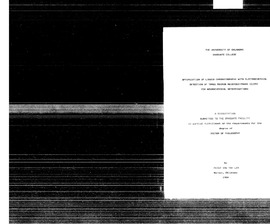| dc.contributor.author | Lin, Peter Yau Tak, | en_US |
| dc.date.accessioned | 2013-08-16T12:29:07Z | |
| dc.date.available | 2013-08-16T12:29:07Z | |
| dc.date.issued | 1984 | en_US |
| dc.identifier.uri | https://hdl.handle.net/11244/5260 | |
| dc.description.abstract | Liquid chromatography with electrochemical detection has become an established technique for the determination of catecholamines, indoleamines, and related enzymes. Previous work in this area has utilized lower efficiency columns, containing packing materials with diameters of five and ten microns. The recent introduction of higher efficiency three micron columns offers the possibility of a significant decrease in the required analysis time. In an attempt to increase sample throughput in our laboratory, these columns were evaluted for utilization with electrochemical detection. | en_US |
| dc.description.abstract | The separation of various neurochemicals was also optimized by adjusting the mobile phase composition. This resulted in the separation of eighteen compounds on one column in less than four minutes, while the same separation can be obtained with a higher degree of resolution on a second column in approximately seven minutes. The general applicability of this technique was demonstrated by its employment in the determination of catecholamines, indoleamines, and related metabolites in whole mouse brains. | en_US |
| dc.description.abstract | Due to the high efficiency of these columns, the eluting peaks are extremely narrow. Instrumental components and various other parameters can drastically broaden the narrow peaks and negate the advantage of these columns. Both the liquid chromatograph and the electrochemical detector were optimized in order to minimize the effects of instrumental band broadening. The optimization process included an examination of system dead volume, pump pulsation, potentiostat time constant, electrochemical cell dead volume, detector spacer thickness, electrode diameter, and electrode material. The results of these investigations showed that an optimized electrochemical detector may be used with these columns without deleteriously affecting their performance. The optimum system includes a modified detector cell with a 1/32 inch diameter carbon paste working electrode, a 0.002 inch spacer thickness, and a time constant of 0.05 seconds. | en_US |
| dc.format.extent | xiii, 188 leaves : | en_US |
| dc.subject | Chemistry, Analytical. | en_US |
| dc.title | Optimization of liquid chromatography with electrochemical detection of three micron reversed-phase column for neurochemical determinations / | en_US |
| dc.title.alternative | Optimization of liquid chromatography ... | en_US |
| dc.type | Thesis | en_US |
| dc.thesis.degree | Ph.D. | en_US |
| dc.thesis.degreeDiscipline | Department of Chemistry and Biochemistry | en_US |
| dc.note | Source: Dissertation Abstracts International, Volume: 45-07, Section: B, page: 2134. | en_US |
| ou.identifier | (UMI)AAI8423984 | en_US |
| ou.group | College of Arts and Sciences::Department of Chemistry and Biochemistry | |
